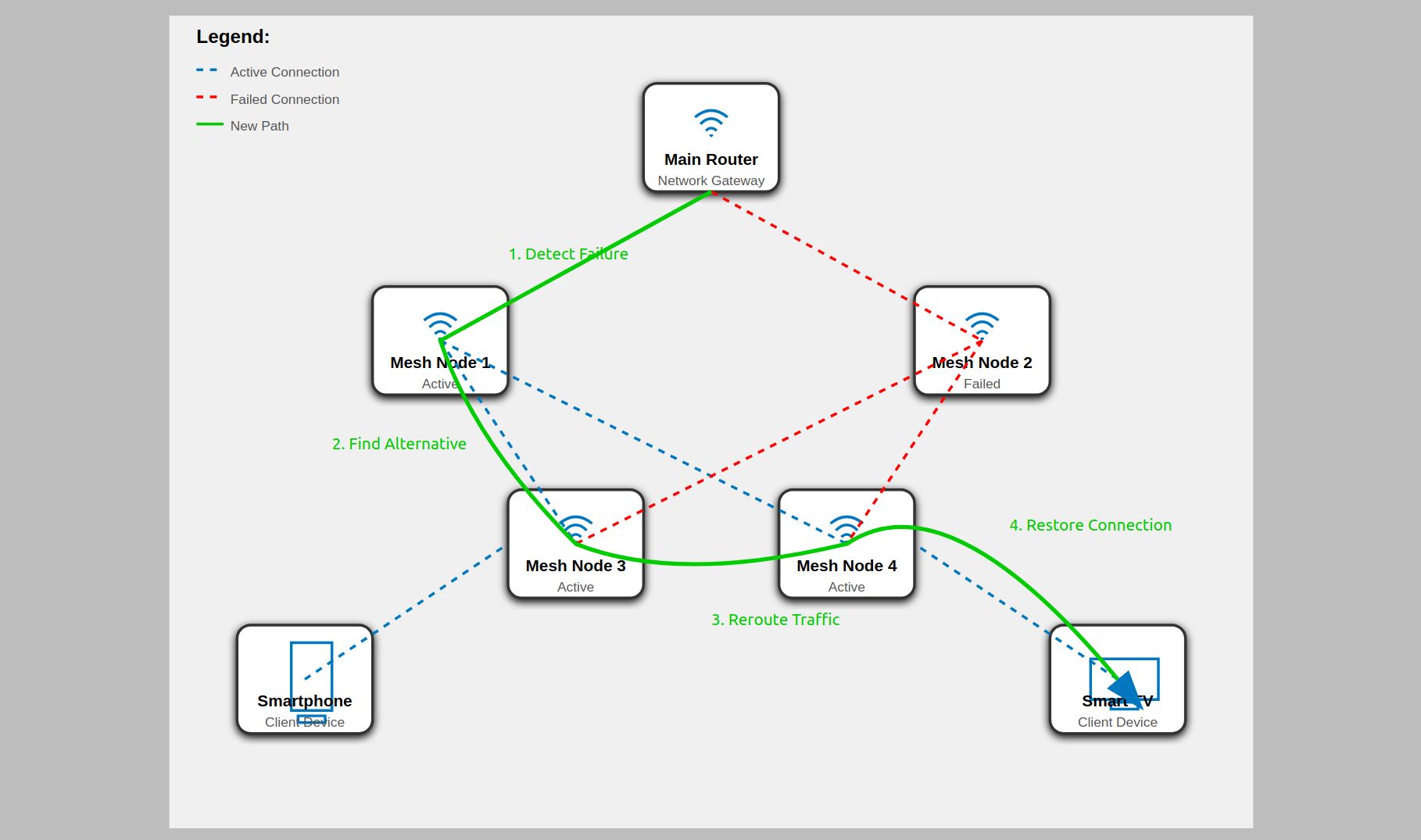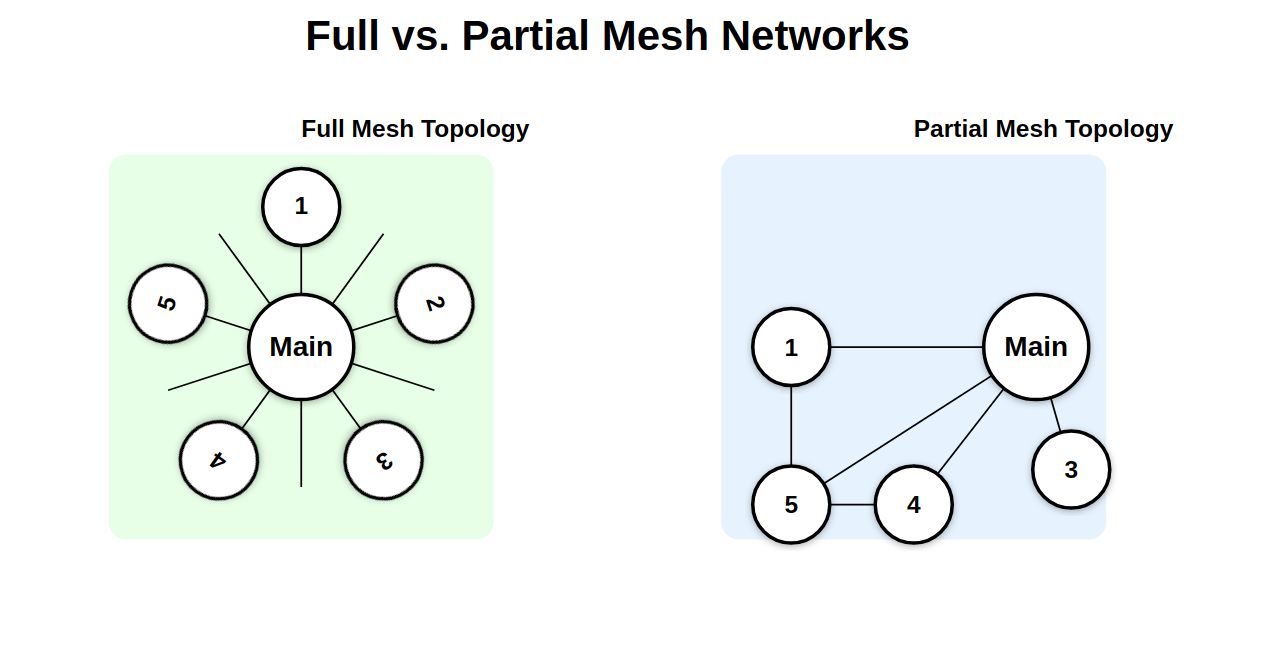What is Mesh Network?
Mesh network is a network topology that enables network devices to talk to each other across various distances. This topology is being used in houses, industry environments and big areas to cover the area with network signals to provide internet to network devices.
In a mesh network, devices work together to pass along data, which helps extend the network's reach. This setup is useful in places where a single router might not cover the whole area, like in large homes or offices with thick walls.

How does it look like?
In general, mesh networks are built with nodes in a network. These nodes are separate special routers that come with pre-installed software. This software ensures that the network is configured and the nodes can communicate with each other through the network.
A key advantage of using a mesh network is its flexibility in node placement. In a mesh network, node locations can be decided based on the user's preferences. This flexible placement helps provide internet connection to areas where the main router's Wi-Fi signals can't reach effectively.

Self Healing
In a big mesh network, maintenance can be a significant challenge for network engineers. When one node goes down, the whole network can be affected by the downtime. If the failed node is the only path to the gateway, it could potentially bring down the entire network until that node is restored.
However, these node devices typically come with self-healing software. This software ensures that data can reach the gateway through at least one node, even if others fail. The self-healing is achieved through algorithms that automatically reconfigure the network paths. These algorithms establish multiple routes to the gateway, so if one node fails, the network can quickly adapt and use alternative paths.
This self-healing capability significantly improves the reliability and resilience of mesh networks, reducing the impact of individual node failures on the overall network performance.
Potential Headaches
The main challenge could be configuring these nodes to communicate with each other and ultimately with the main gateway. However, today's modern technology enables seamless configuration between the nodes. Adding a new node to the network is often as simple as opening a mobile application (which varies according to the vendor) and scanning the network to discover the new node.
Another potential issue is that some nodes may have limited range, which could require network engineers to add more nodes to the network. As you might expect, this additional hardware comes with increased costs.
On the other hand, many of these nodes now come with 5 GHz wireless connection capabilities, which can provide longer-range connections and help address the coverage issue. Speed is also important. Many of these node devices support connection speeds of up to 5 Gbit/s when connected through the Ethernet port, though actual speeds may vary depending on various factors.
Use Cases
Mesh network can be utilized in various scenarios:
- Home Network: In some cases if the house is big the main wifi signals are not sufficient and create dead zones in the house. In this case, mesh network can extend these wifi signals to the dead zones to provide internet.
- IoT Devices: In urban areas, mostly farmers or some entities use sensors to obtain information about their business. This requires them to have internet connection to these sensors. Therefore, implementing a mesh network brings network to these sensors.
- Disaster: When a natural disaster happens and the network infrastructure is affected, implementing a temporary mesh network can be the fastest solution.
- Schools: Since schools are big in terms of m^2, overall area is too big to cover with one router. Mesh network can cover such distances without an issue to provide internet to the whole school.
Monitoring
Network mesh network topology is highly beneficial in terms of providing internet in dead zones or areas with limited connectivity. However, they are also beneficial for network monitoring. These network nodes come with their own configurable interfaces where the administrator can decide which services the node can access and which it can't.
This feature adds an extra layer of control and security to the network. Administrators can:
- Manage traffic: Prioritize certain types of data or limit bandwidth for specific services.
- Implement security policies: Block access to potentially harmful or inappropriate content across the entire network.
- Monitor usage: Gain insights into network usage patterns, helping to optimize performance and identify potential issues before they become problems.
- Customize access: Set up different access levels for various user groups or devices connected to the network.
- Troubleshoot efficiently: Pinpoint issues to specific nodes, making it easier to diagnose and resolve network problems.
This level of control and visibility across the entire network is particularly valuable in larger deployments, such as enterprise environments or smart city initiatives, where managing network security and performance is crucial.
Conclusion
Briefly, mesh network is an extended local area network that brings wider network accessibility. This network topology doesn't only bring extended network access but also provides self-healing, flexible node placement, and better network monitoring. Mesh networks fix connectivity problems in many situations, like big houses, schools, IoT setups, and after disasters.
While setting up can be tricky and sometimes costly, new mesh systems are easy to configure and offer fast connections. Mesh networks can adapt to different places and give strong, far-reaching coverage. They're a big step forward in network technology, especially good for our world where everything's getting more connected.
